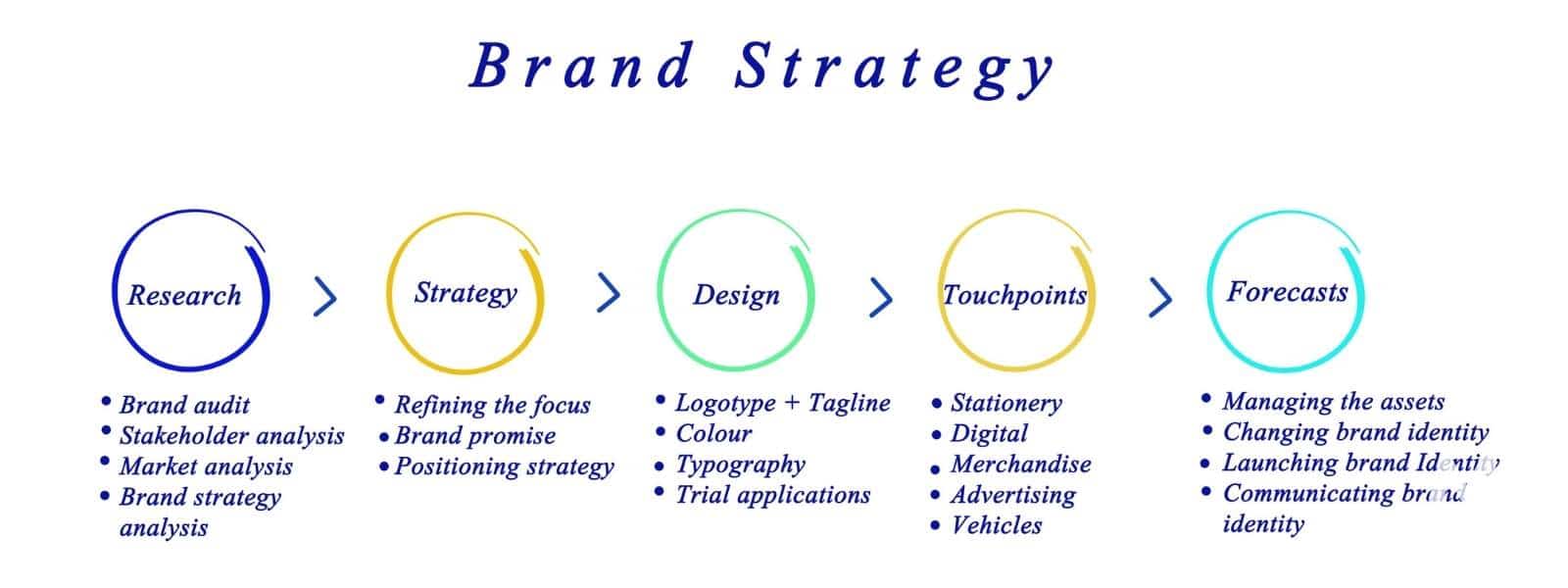Use These 11 Proven Steps for your Brand Development Strategy and Professional Services Company
The article will cover 11 easy steps for brand development strategy.
Branding is not just a marketing term. Branding is about how you behave and what you say as an individual, and branding is your brand related to your profession.
Branding is one of the most important aspects for any company to survive in today’s competitive market.
Branding not only helps you stand out from competitors but also gives customers confidence about your brand, which leads to more sales and profits for you!
Whether you are rebranding your company or launching a new branding this article will cover the critical elements for more success.
Brand Development Strategy for Your Professional Services Firm

- Brand development strategy includes developing core values that will help shape the brand of your company or organization. It also involves the essence of the brand’s identity and the personality of its founders, which will be communicated through all facets of branding logos, colors, slogans, products or services offered, etc.
- You should create a plan for where you want to take your business to make sure it aligns with who you are and what value can provide.
- The brand story defines the main theme of your brand, and it provides a sneak peek into who you are and what you do.
- Brand stories should focus on 2 – 3 underlying messages that can be combined into a paragraph or two to describe the brand’s essence.
- Create an illustration style guide that outlines how illustrations should appear in all branding materials such as social media images, blog post images, etc.
- Branding style guide will help make sure everything is consistent with your branding message. It will include specific fonts, colors, typography, and logo size
- Create a tagline to summarize your brand story
- Branding is not just about how you look but also how you behave. Your branding strategy should include developing core values that will help shape the brand of your company or organization.
- Brand development strategy includes developing core values that will help shape the brand of your company or organization.
- Core Values are the foundation on which everything else is built. They’re what makeup who you are as an individual or business.
- Brand Guide Book
- Editorial Calendar
- Tagline
- Illustration Style Guide
- Branding is not just about how you look but also how you behave.
Brand development plan for your professional services

Every brand has a story, and it’s the reason why people connect with your brand.
- To establish consistency with all branding materials, you need to create an editorial calendar
- You should create a plan for where you want to take your business to make sure it aligns with who you are
- A Branding Committee should put together a Brand Guide Book that features your brand story and core values
- The brand message is the main idea you want to convey through your branding.
- Establishing a style guide is the first step in helping achieve consistency as part of your brand development strategy.
- Developing brand values helps shape the overall brand experience
Branding is the process of creating a name, symbol, or design that identifies and differentiates a product from other products. Branding can be seen as an investment to increase sales and profitability for your business.
11 steps need to be followed according to this article:
- Create a brand committee
- Identify your target market and competitors
- Define your company’s purpose
- Brand values
- Brand platform
- Brand mapping
- Brand personality
- Brand identity
- Brand architecture
- Brand positioning
- Value proposition
1) Branding committee

The first step is to create a branding committee consisting of team members from marketing, PR, product development, or even founders.
A Branding Committee should create a Brand Guide Book that features your brand story and core values.
As part of the branding committee’s task, they need to develop a Branding Style Guide which is a document that outlines how brand-related content should be used across all channels. The style guide should include logo usage guidelines, color palettes, and typography.
To establish consistency with all branding materials, you must create an editorial calendar to plan what content you’ll publish and when.
2) Identify your target market and competitors
You need to identify your target market before developing a brand strategy because it will help you understand how they think, what their needs are, what their expectations are, etc. Branding and marketing should be tailored to meet those needs.
You first need to list all competitors or similar companies in your industry to start researching them. The more information you have about your competitors, the better it will be for developing a brand strategy as you will know what their target audience thinks about them.
After getting information from each company’s market share, customer data, etc., try to find out who their most valuable customers are.
How are they targeting this group of people? Proper competitive analysis will help you understand how branding works in different industries. When it comes time to brand your own business, you’ll have an easier time picking which set of customers to target and how to do it.
3) Define your company’s purpose
A Company’s Purpose is the collective goal of a business. It defines why a company exists, what matters most, and how it’ll do its best work. Branding begins with purpose. There are three important steps to understanding your company’s purpose:
- Who are you?
- What do your customers want from you?
- How will you deliver this value to customers over time?
4) Brand values and brand development strategy for your professional services
You need to decide what your brand identity will be before you start building a brand around it. Branding is not just about having a logo. But it also involves the complete image of the company.
That’s why developing branding is one of the most challenging tasks in marketing. Various branding components include name, tagline or campaign slogan, colors, symbols, etc.
These elements will identify your product from others and make sure they remain unique while doing so. When creating a brand identity for your business, you should consider some factors.
5) Brand platform

The brand platform is the core values and attributes representing your brand. The brand platform is what people should recognize in you and resonate with them to connect with you better.
Branding means creating an emotional value for your customers so that brand identity should resonate with them deeper than just rational thinking.
Brand positioning is based on the brand platform, needs, and expectations. It helps align business, marketing, and branding strategies by identifying where the company wants to play in the market and how it plans to win over competitors.
6) Brand mapping
Brand mapping consists of selecting or organizing logos according to their characteristics, which will help you visualize how each logo matches up against criteria such as color, style, type, etc.
Brand mapping helps you visualize and understand the visual elements of branding better and allows you to see how each component of your brand is working with others and how they make up your company’s identity.
Brand mapping also shows which brands are closest in terms of their values so you can learn from them and develop a unique brand positioning for your business.
Brand mapping helps marketers analyze their brand’s positioning by comparing it to their competitors or by studying other companies in the same industry that are taking successful steps to differentiate themselves from others.
Brand mapping is done with the help of SWOT analysis, PEST analysis, and Porter’s five forces, which provide marketers useful information about how they need to position their company to separate themselves from others and stand out when people communicate with them.
Brand mapping includes:
- Brand Strength: Brand strength represents your brand’s personality and how you portray yourself in front of your target audience. Brand strength is usually determined using brand values, brand personality, etc.
- Brand Image: Brand image represents how you are perceived by your potential or existing consumers in the market. Brand image is also determined based on brand value, personality, activities, etc. This helps marketers create an emotional connection with their target group to be remembered when people look for similar services in the future.
Brand development strategy is one of the most important aspects for professional services firms.
Branding helps professionals develop a unique image that can be used as an effective marketing tool to create brand awareness, build relationships with customers and increase revenue.
7) Brand personality and brand development strategy for your professional services
Various models, such as the 4C or 5C model, help marketers choose a specific archetype representing their product emotionally through different characteristics.
Choosing an appropriate archetype is to achieve consistency between what customers expect from a brand and what they get while using it or buying it.
In order to help you create your brand identity, brand archetypes can be a good place to start.
These brand archetypes will allow you to understand who your ideal clients are and what they need from you. Brand Archetypes can also help you find the perfect name for your brand that reflects your Brand’s personality.
8) Brand platform

Brand identity includes different symbols and elements such as colors, fonts, logos, etc., which will make your brand recognizable to your target audience.
Branding is not all about having a brand name; it also involves the complete image of the company. That’s why developing branding is one of the most challenging tasks in marketing.
Brand identity has five basic elements:
- Brand Name: People usually recognize you and what they say while identifying you within the market or industry.
- Brand Tagline or Slogan: This part helps differentiate and describe your brand in a few words to better understand you and your clients.
- Brand Symbol: It might be a logo, picture, or other unique symbol representing your brand and differentiating it from others.
- Brand Colors: This is the most important part of branding because colors represent your brand’s personality, psychology, and unique characteristics in a visual form that help people remember you.
- Brand Fonts: Brand fonts are usually used for representing the brand name or tagline in written form. Branding is not all about having a brand name; it also involves the complete image of the company. That’s why developing branding is one of the most challenging tasks in marketing.
9) Brand architecture

The brand architecture consists of 3 main parts, defining what products you will offer to your consumers and brand positioning and how you will present yourself in the market.
The brand architecture includes:
- Brand Core: This refers to your company’s values, mission, vision, etc., which make up the foundation of your business. Brand core reflects what you want to do for customers and how you plan to satisfy their needs through your products or services.
- Brand Family: The brand family represents all other brands or sub-brands related to each other within the same company that shares the same brand core but has different qualities and target demographics. The brand family idea helps marketers manage the image of individual brands according to their target group’s preferences when people communicate with them. For example, a buyer looking for financial services will expect to have more data before making a final decision. The brand family includes products or services that can be offered along with the brand core and help marketers support the main line of business.
- Brand Extension: Brand extension represents products or services related to your main brand but comes from different companies that have the same target audience as your company. The brand extension helps marketers use their existing recognition and target group to promote new products or services that will help them diversify into newer business areas without creating a new brand. This way, they can show diversity within their company, develop unique marketing strategies and increase revenue simultaneously. Brand extensions usually look like an additional family rather than an independent brand on their own.
10) Brand positioning and brand development strategy for your professional services
Positioning is one of the most popular marketing strategies for product differentiation. It helps marketers create a unique image for their brand or company to stand out from the rest of their competitors who are offering similar kinds of services or products at the moment.
Brand positioning mainly focuses on making companies differ in terms of their features, functions, benefits, etc.
Because there are only so many ways one can be better than others; therefore, brand positioning is all about creating a clear picture for customers about how you are different from the rest.
Brand positioning strategy stands for your company’s position within the competitive industry based on the benefits you provide to customers and solutions you offer according to their needs. Brand positioning strategy includes the following aspects:
11) Value proposition
Brand value proposition and brand development strategy for your professional services represent an organization’s main service or product offering to its employees and customers.
Values are guidelines for actions that help marketers make decisions in the future by focusing on what they think is important while performing certain activities related to their business.
Brand values help companies set standards of conduct for their employees, which means that values should influence hiring, marketing, communication, etc. It affects your operations as a whole brand strategy.
Brand values represent what kind of culture you have within your company and how you want people to perceive your brand when they see it from the outside to be attracted effortlessly because of the right positioning and awareness created around your brand.
Brand values should be authentic to ensure all team members clearly understand them.
Brand values help marketers focus on what matters most to their brand and build consistency between the team’s actions and messages to customers.
Conclusion and brand development strategy for your professional services
Branding can be confusing, but it’s important to get it right.
Branding is the process of creating a unique name and logo for your company so that you stand out from other companies in your industry.
Branding helps customers identify with your brand and decide what they want to buy from you based on their perception of your company.
Branding also includes all the marketing materials related to your company, such as logos, colors, fonts, etc.
We’ve put together an 11-step branding strategy guide for professional services firms looking to create or refresh their brand identity!
FAQs about the brand development strategy
What is Brand Development Strategy?
Brand Development Strategy is a team or individual effort to create and maintain a Brand. Brand Development Strategies start with the company’s Vision and Mission, take an in-depth look at the company’s competitive environment and then establish Brand Behaviors that will deliver on these.
Brand Development Strategy: what does this mean?
Brand Development Strategy: Brand Development is a team or individual effort to create and maintain your professional services company brand identity. Brand Development Strategies start with the company’s Vision and Mission, take an in-depth look at the company’s competitive environment, then establish Brand Behaviors to deliver on these. A Brand can be seen as an image of a company in the marketplace.

